Capital:
Hanoi
Currency
Dong
Best time to visit:
The climate varies from region to region. In winter (January to March) it gets really cold only north of Danang. In the center and north of the country, from July to November, unpredictable and violent typhoons break out. The best times to visit the country are: from December to February (for the south), from February to May (for the center) and from November to the beginning of May for the north.
In a word:
xin chào (hello)
Vaccines
With the exception of a few areas at risk, malaria is quite rare in the country; it is absent in urban areas, in the Red River Delta and in the central coastal plains.
Warnings:
- Do not drink water from the tap
- Outside of Hanoi and Ho Chi Minh City, health facilities are rather poor.
- Beware of monkeys which can be quite aggressive.
At the table:
Rice and noodles are the pillars of Vietnamese cuisine that is not too spicy and does not create big problems for the weakest of stomachs. The need for sweet and vitamins is satisfied by fruit, which is varied and delicious, in particular by the pitaya (dragon fruit)
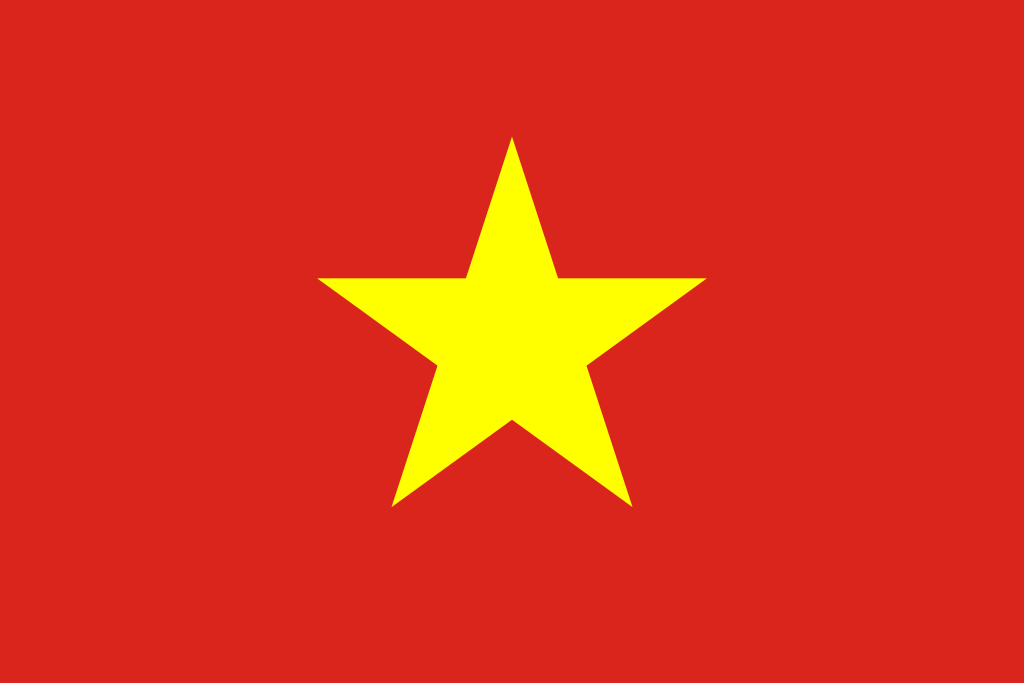
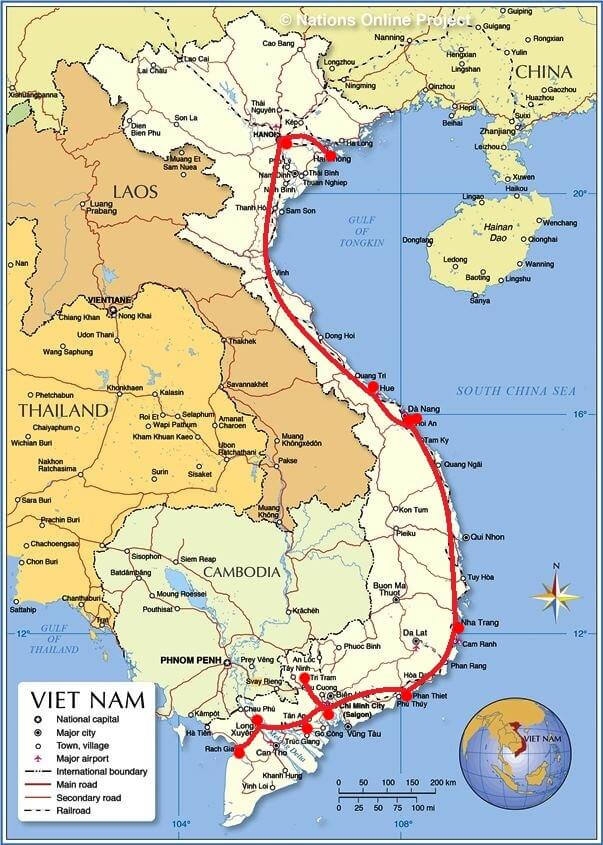
Essential experiences:
Enter the tunnels used by the Vietcong at Cu Chi to experience the sensations experienced by the Vietnamese military during the famous war; Marvel at the picturesque town of Ho An where time seems to stand still; Paddle a kayak in the beautiful Halong Bay
Vietnam offers a great variety of natural and cultural landscapes and will not fail to amaze the traveler by making him discover the wealth of traditions, customs and lifestyles that the country enjoys.
It is a country that has suffered so much in the past but has now completely opened up to tourism, becoming one of the most desired destinations in all of Southeast Asia.
Very welcoming country, easy to get around and very cheap. For DIY travelers, like us, we usually start from Ho Chi Minh City (south of the country) and slowly ascend to the capital Hanoi (north) or vice versa.
We recommend purchasing a travel booklet from one of the many tourist agencies to travel in comfortable and safe buses equipped with seats that almost transform into real beds and connect the main Vietnamese cities.
We began our exploration of the country from old Saigon, now Ho Chi Minh City, and after visiting the southern part of Vietnam and the Mekong Delta, slowly, by land, to fully appreciate the local wonders, we went back up to the its capital and the picturesque Halong Bay, defined as the eighth wonder of the world!
Our suggested itinerary (30 days) | |
First week: | Ho Chi Minh City, Cu Chi tunnels, Mekong Delta |
second week: | Phan Thiet |
third week: | Nha Trang, HoiAn |
fourth week: | Hue, Hanoi, Halong Bay |
Here we are in Ho Chi Minh City (formerly Saigon). The first thing that strikes you and that will haunt us all the time are: the scooters ... Rivers, oceans of centaurs, almost all aboard a few copies of "Hello" or "Yes" that run in all directions, on the sidewalks, by two, by three, by four, and they carry everything! I even saw one carrying a full glass window!
When they notice that you don't have almond eyes, they smile and say hello ...
The typical sightseeing tour hastily touches the Reunification Palace, the Cathedral of Our Lady, the Central Post Office and the Ben Thanh market.
Old Sai Gon offers so much more than that.
Ho Chi Minh City is an unmissable destination for those who want to know the history of the Indochina Wars. Numerous and very interesting are the historical sites that give an account of that tragic period.
Tra di essi non mancate il Museo dei Residuati Bellici.
Two floors show photos and artifacts of those terrible years and perhaps, for the first time, after dozens of American films in which the Vietnamese were portrayed as enemies to fight, here they now appear as victims and we begin to see that conflict from a different point of view.
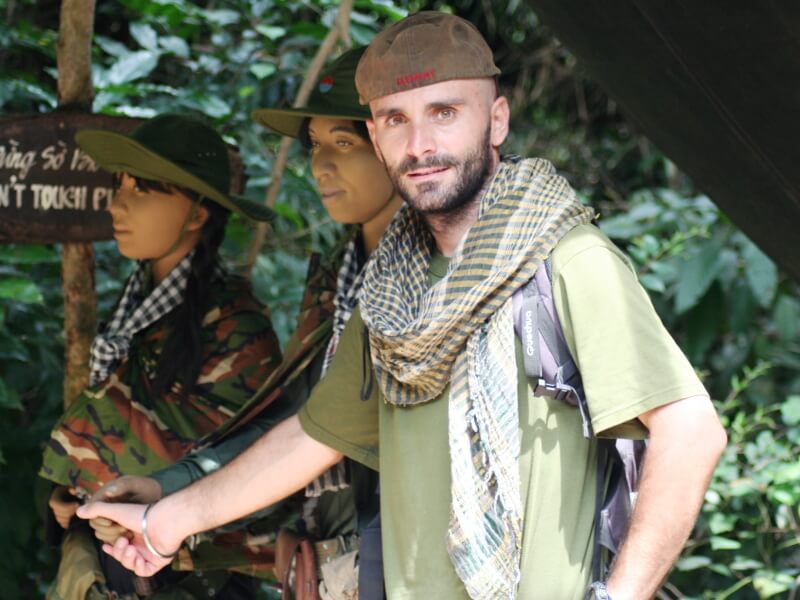
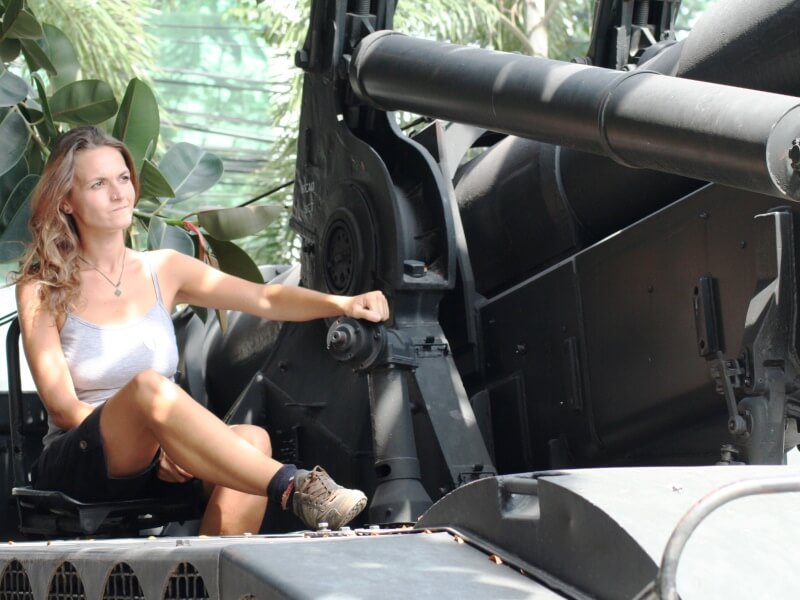

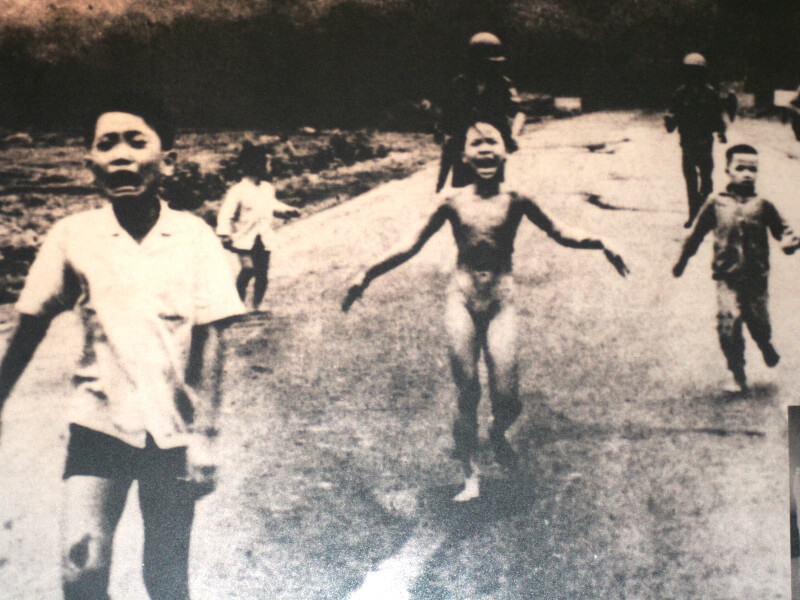
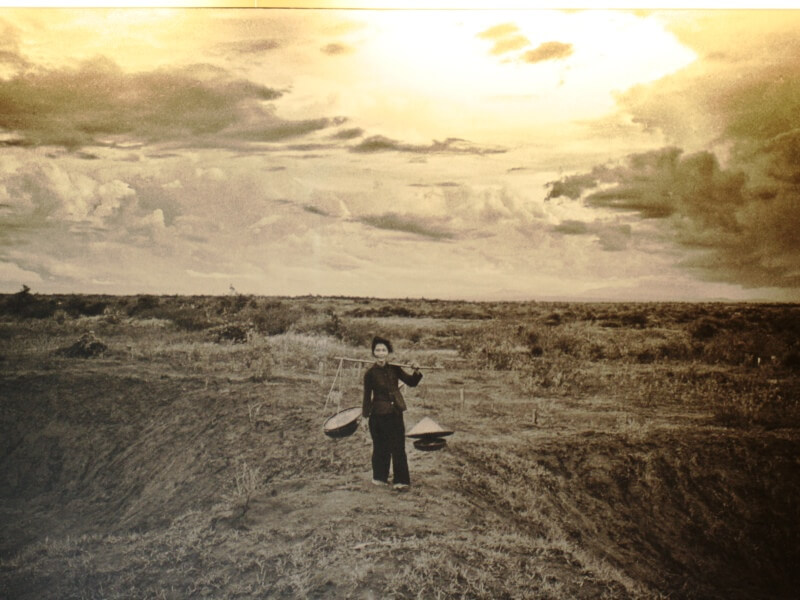
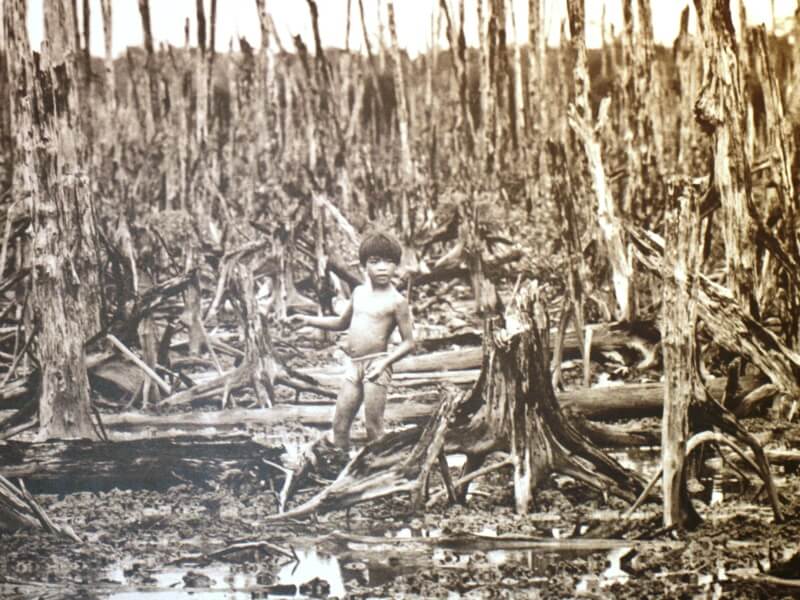
Visit to the Cu Chi tunnels which follow almost 250 km long routes and which were built by the Viet Cong during the French occupation at the time of the conflict against America, and even reach the city of Saigon. We ventured together with the guide in one of those tunnels ... they are very small and very long, but absolutely to be avoided if you suffer from claustrophobia.
Do not miss a visit to Cho Lon, the Chinese city. Here it is possible to visit magnificent temples built by the Hoa communities (Chinese mainly from FuJian and GuangDong).
Then the Thien Hau Pagoda, the oldest pagoda in the city, dedicated to the Celestial Lady protector of navigators and sailors. At the entrance we were given spirals of perfumed incense which, by burning, contributed to creating a mystical atmosphere that conforms to ancient tradition.
A couple of hours by bus from old Saigon, we reach the islet of Thoi Son by crossing the mythical Mekong with a boat. This river was born in Tibet, it crosses: China, Vietnam, Cambodia, Myanmar, Laos and Thailand ... an immense river ... about 8 km wide ...
We embark on a small canoe that takes us through inlets and small very suggestive canals ...
Every now and then some small scorpion appears ... while our canoe glides lightly in that equatorial paradise ... Peace, silence broken only by the relaxing sound of the oar in the water as we continue along those river channels swallowed by the great green patch of nature ...
A characteristic of Vietnamese girls is the obsessive fear of getting a tan ... they try to keep their skin as white as possible, and so you see them dressed, even at 30 ° in the most ridiculous and unthinkable ways ... and colorful mask that covers the face from nose to chin (and I thought they used it against smog!); the most ridiculous thing are the long gloves up to the armpits ... woe to leave a small space uncovered ... and how do they protect their feet since they only use slippers? Don't worry… there are socks for maximum protection, but the icing on the cake is the hat! Since the helmet is not mandatory, they all wear caps and, consequently, everywhere you see little men selling real towers of caps, all strictly NIKE: fake!
We continue our journey south to Phan Thiet, a lively fishing port, full of colorful boats, lively open-air markets and fish restaurants. Ideal for a little break away from the chaos of Saigon and before starting the slow journey to the north!
We took a long walk along the beach to a wonderful fishing village ... These were in full swing, some were folding their thin nets, others were returning from their fishing trip aboard curious little boats with the characteristic shape of giant coconut ... child and a lady digging in the sand looking for clams ...
Today we decide to better explore this delightful town and we do it aboard a very nice "rickshaw"!
We visited various Pagodas and temples, including the Vạn Thủy Tú, dating from around 1762, dedicated to whales, whose skeletons are preserved here along with those of other local marine creatures.
Popular market ... Perhaps it was the first time that tourists had set foot in that place given the welcome! People looked at us, they touched us even if we were Martians, I stopped to buy a hat, a crowd of people gathered to observe, three or four I needed, the others watched the scene ...
The food area does not shine for hygiene ... here they sold the meat by leaving it resting on wooden benches full of flies ... every now and then some rats crossed the road ... but all very characteristic!
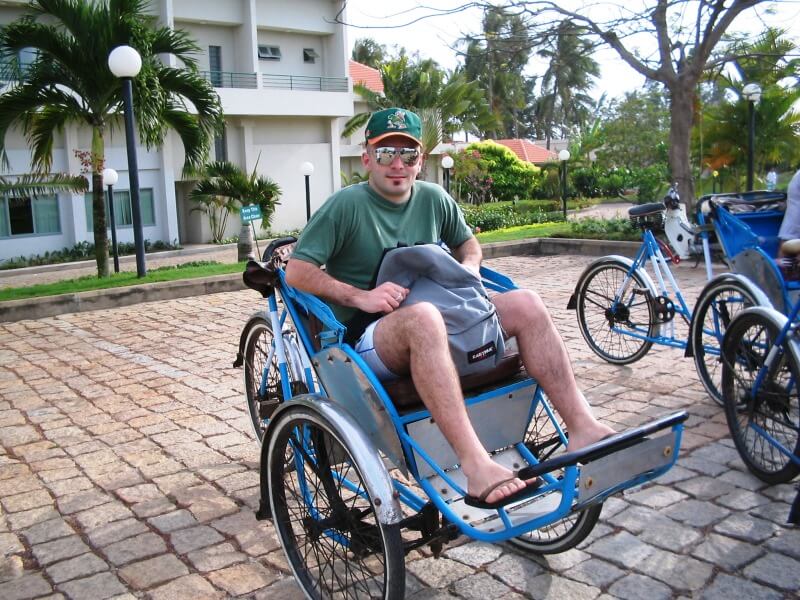
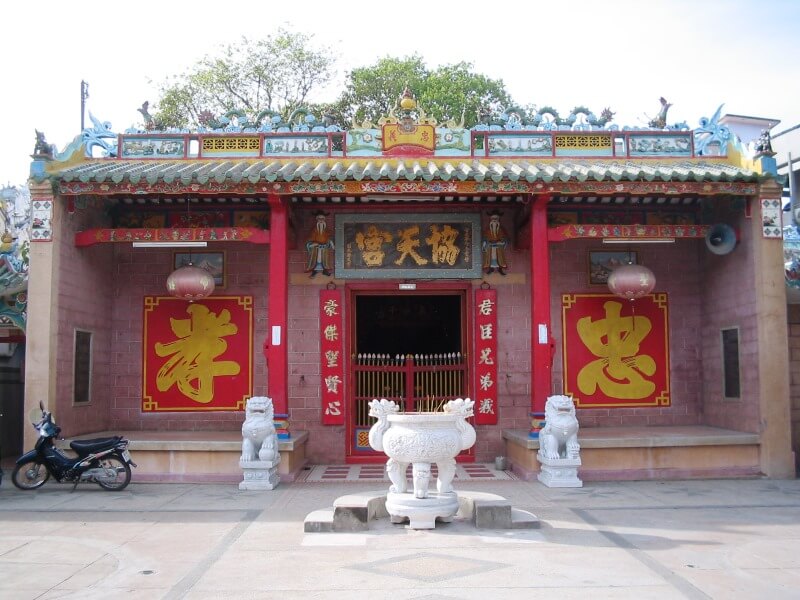
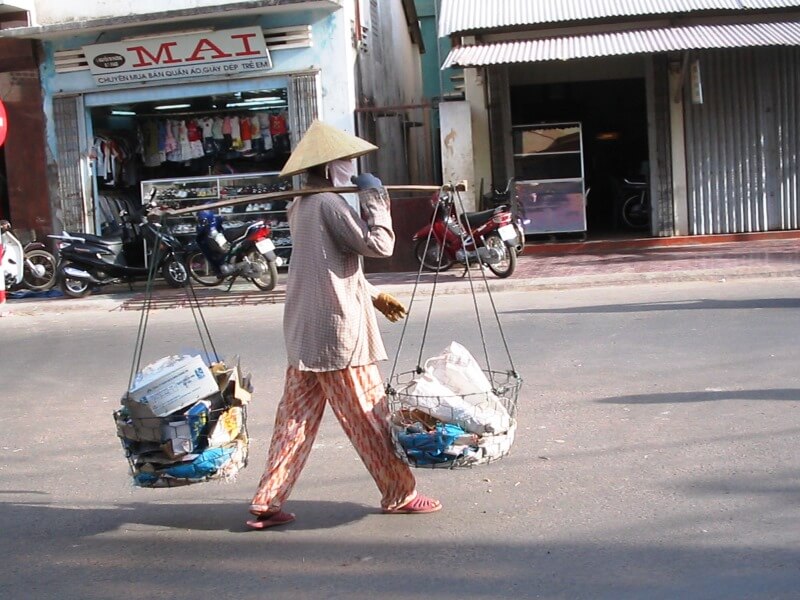
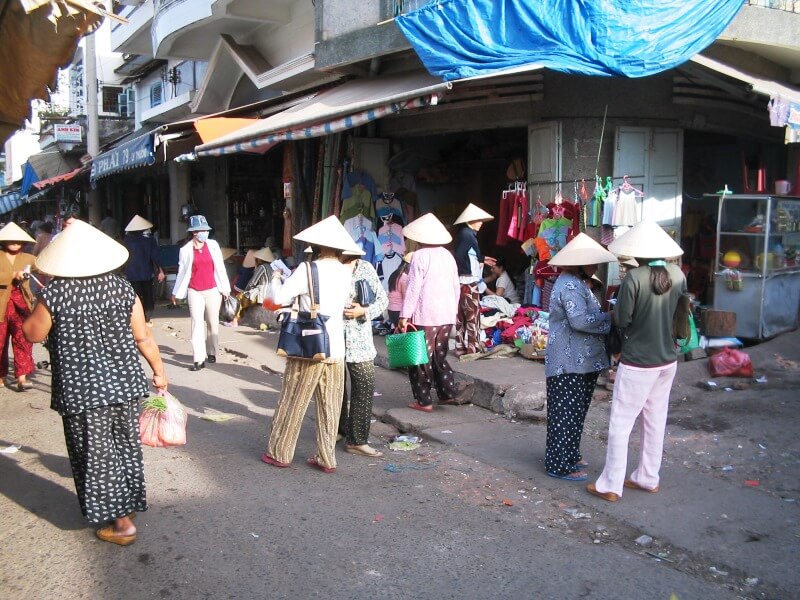
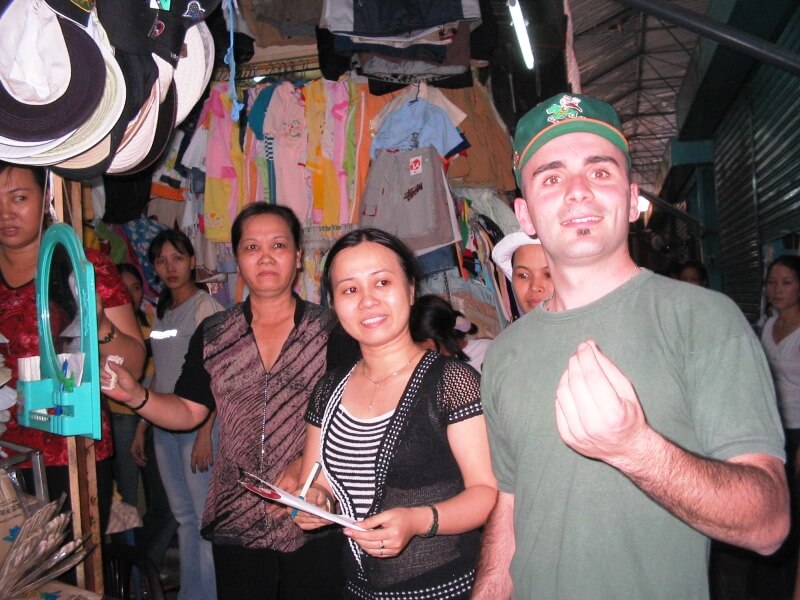
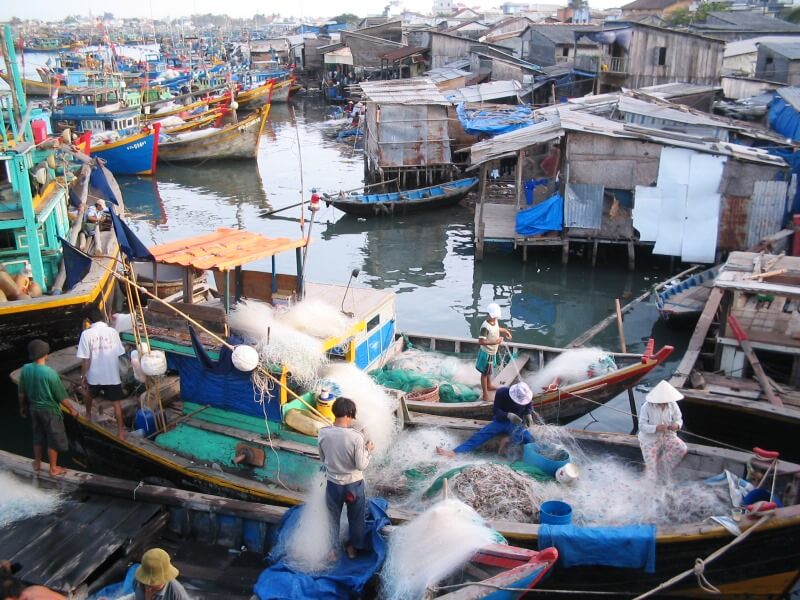
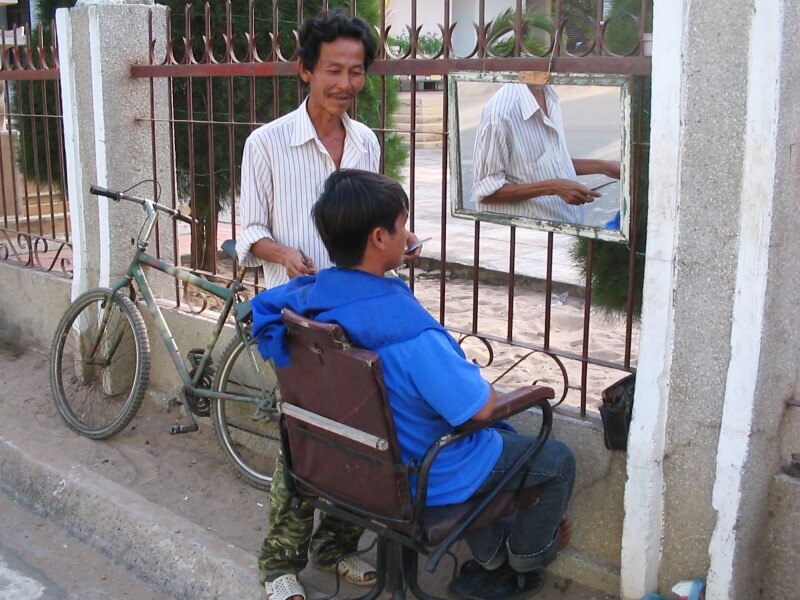
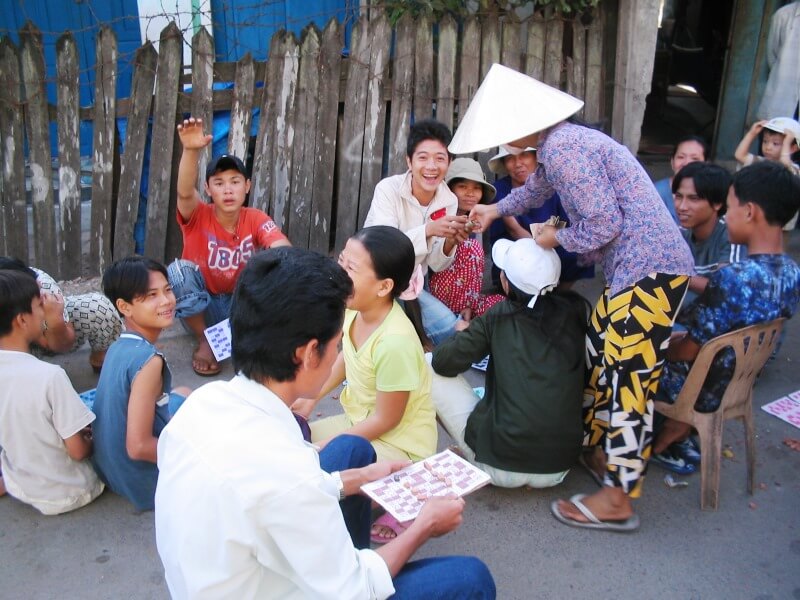
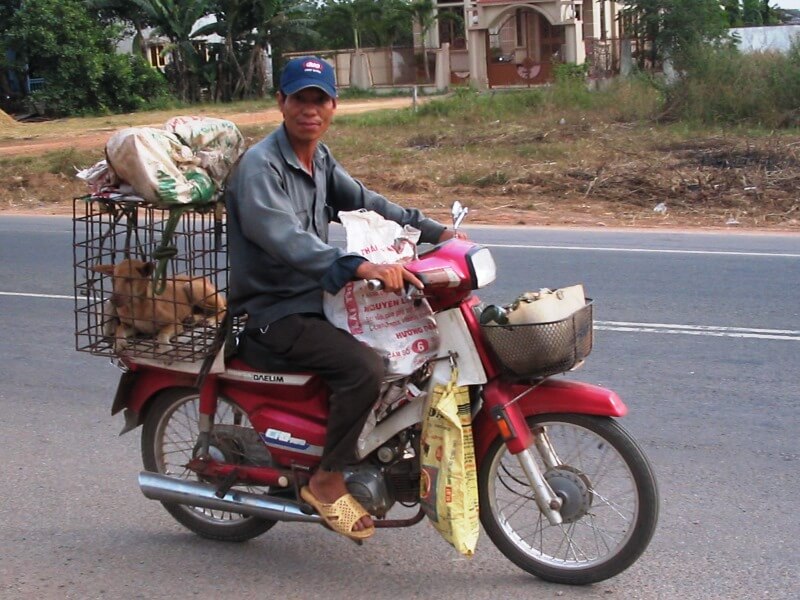
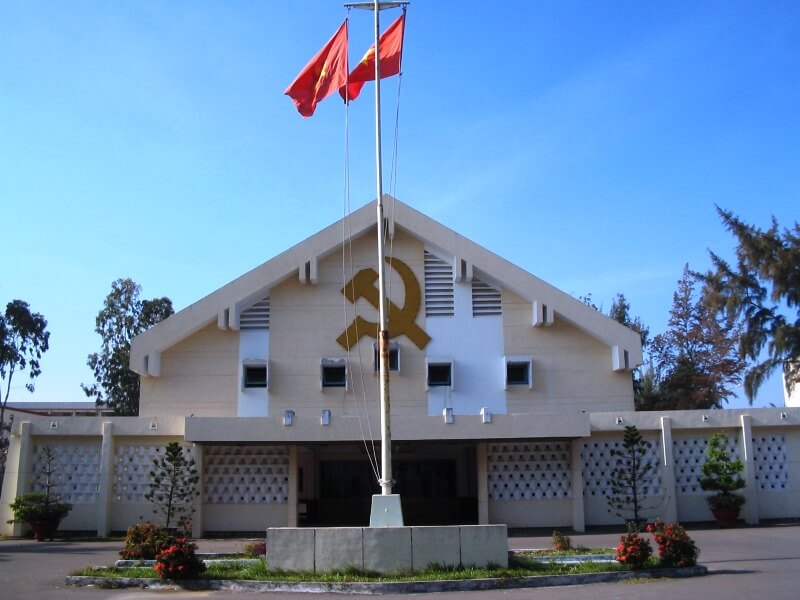
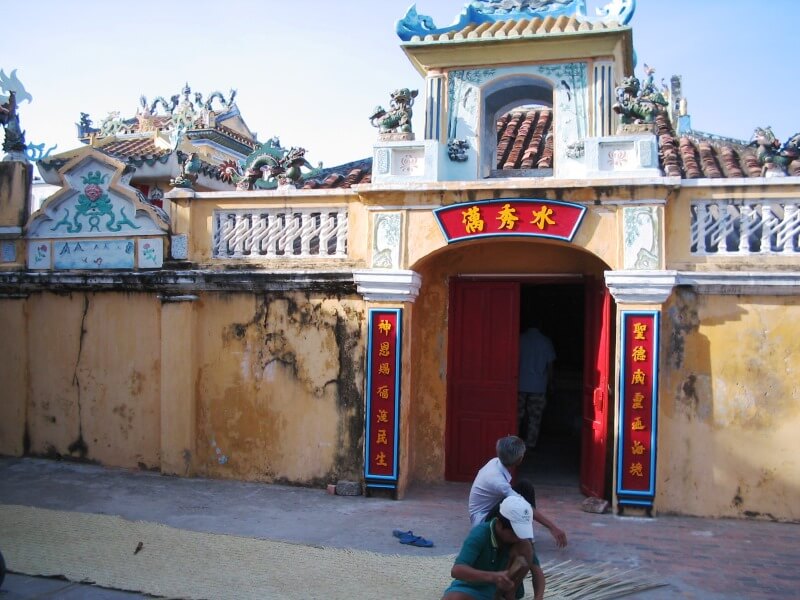
Day trip to Mui Ne, famous for its streets covered in the shade of coconut trees, beautiful beaches and sand dunes glistening in the sun.
It is also known as 'Flying Sand Hill' which stretches for several kilometers from Binh Thuan to Ninh Thuan. The colors of this area are very strange and are the product of the mixture of the colors of the old iron mines together with the yellow sand. The shape of the sand always changes due to the erosion of the wind that sweeps away the thin upper layer, creating ever new shapes.
Using the book of bus passes (mostly at night and very comfortable) purchased in Ho Chi Minh City, today the ascent to the capital begins.
First stop: Nha Trang!
I think I will long remember this tough overnight transfer. The driver of our old bus drove in a very dangerous way.
Fortunately we arrive at our destination safe and sound around 6.30 in the morning, then we are in our cute guest-house, near the sea!
Finally a bit of relaxation. We really wanted!
Nha Trang is the capital of the Khanh Hoa province, located in south-central Vietnam. The city has long been one of Vietnam's beach tourism destinations and mainly attracts Russians and Chinese.
The city itself doesn't have much to offer other than a long beach and vibrant nightlife but it is an ideal home base on the Ho Chi Minh City - Hanoi route.
Around Nha Trang there are beautiful beaches and islands ideal for excursions and stays by the sea.
When I think of this town, only the delicious tropical fruit breakfasts come to mind in the morning, the whole days spent basking in the sun reading a good book, swimming in this inviting sea, strolling along the avenues in celebration!
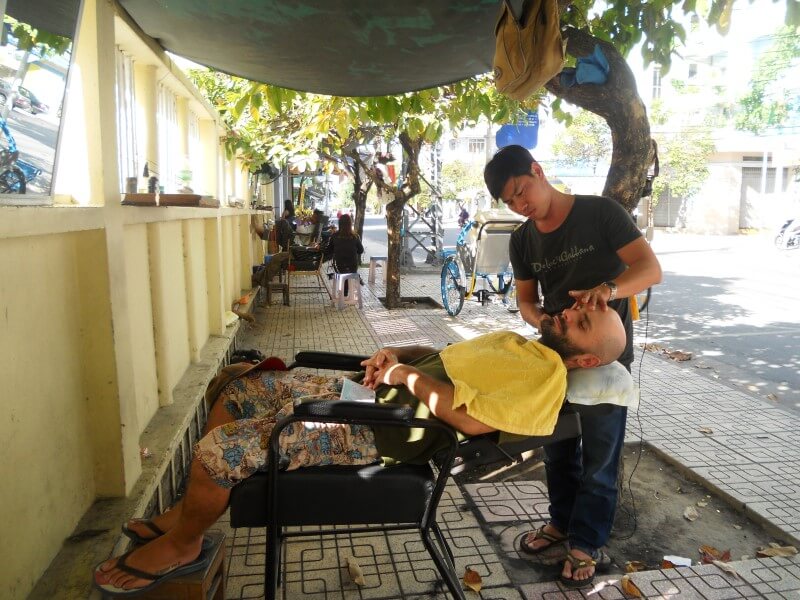
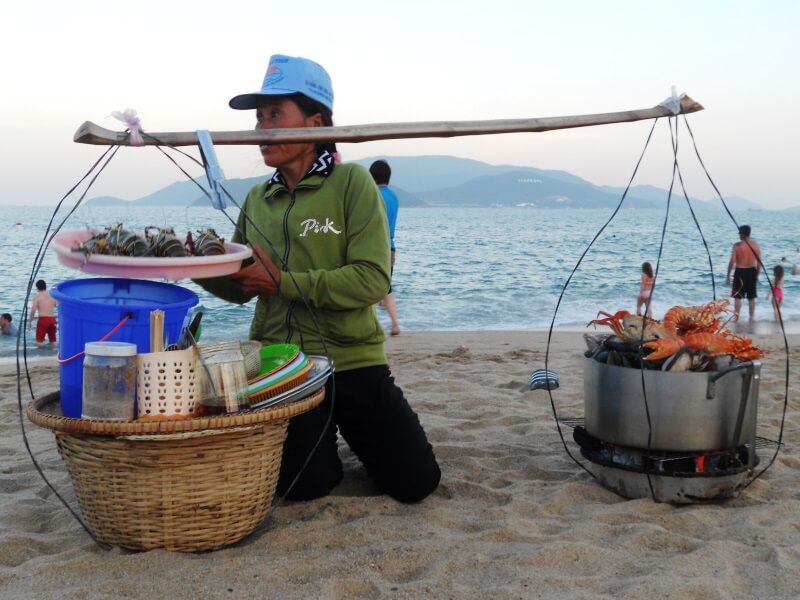
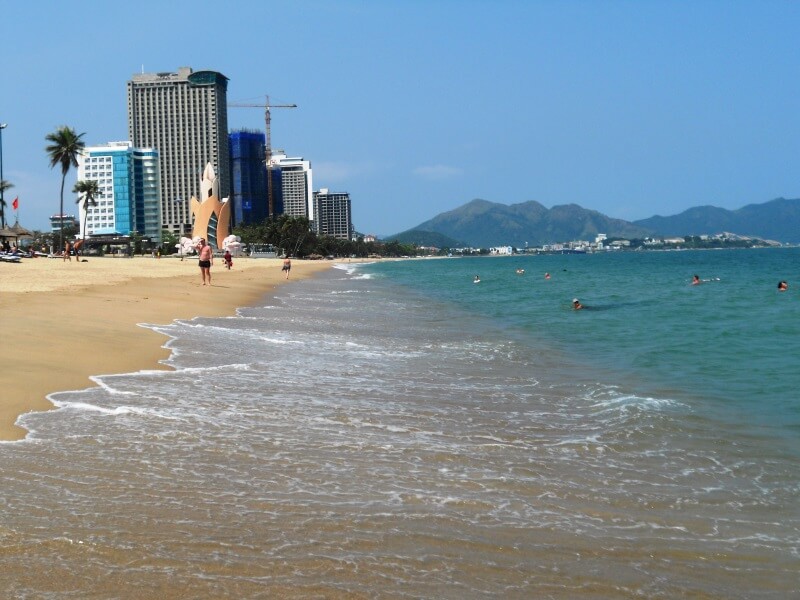
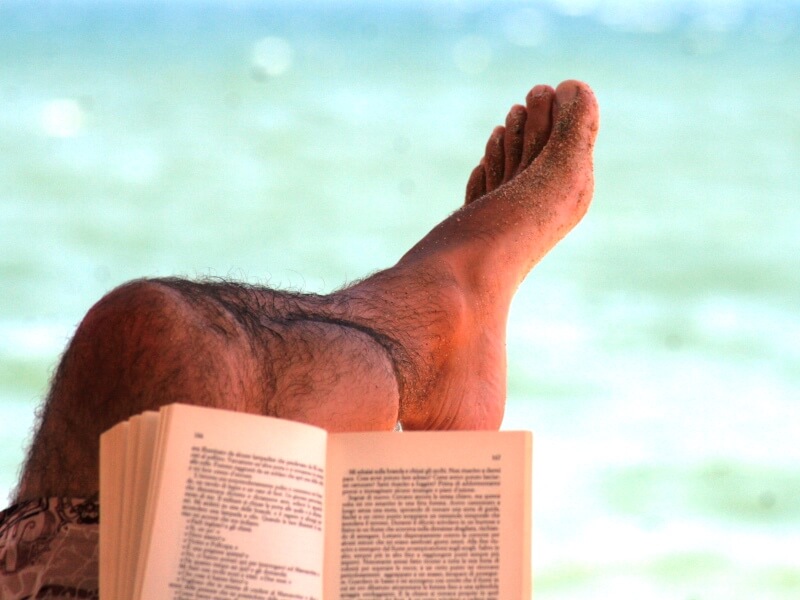
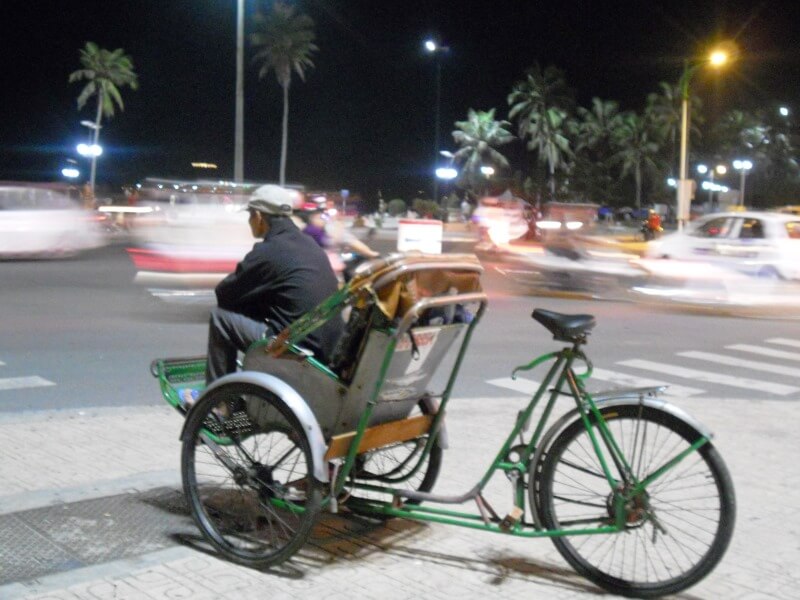
Night on the bus and at dawn, here we are in this little gem, without a doubt my favorite city in Vietnam!
Even if it's only seven o'clock we take a stroll downtown ... it's early but everything is already in turmoil, elderly people doing "tai chi" in the courtyard of a Chinese pagoda, the first children who, in pure white uniform, ride a bike they go to school.
Everywhere there is an air of other times, it seems that here the calendar stopped 150 years ago. There is an unreal silence and peace broken only by the roar of the water that flows under the many bridges that characterize Hoi An.
Hoi An, known as the “city of lanterns”, a nickname due to the hundreds of silk street lamps that illuminate the streets of the town. The city is a merchant port declared a World Heritage Site by Unesco in 1999, full of historic buildings and traditional markets. It preserves an ancient historic center and numerous valuable architectural testimonies, the result of frequent cultural exchanges between Vietnam, China and Japan.
The center invites to pleasant and slow walks. Via Tran Phu is the tourist promenade par excellence. Along it are temples, museums and the magnificent halls of the Sino-Vietnamese congregations.
The Japanese Covered Bridge, made of wood and stone and decorated with traditional Japanese statues, and the Quan Cong Temple, built in the 17th century to honor the deeds of the Chinese general Cong, are worth a visit.
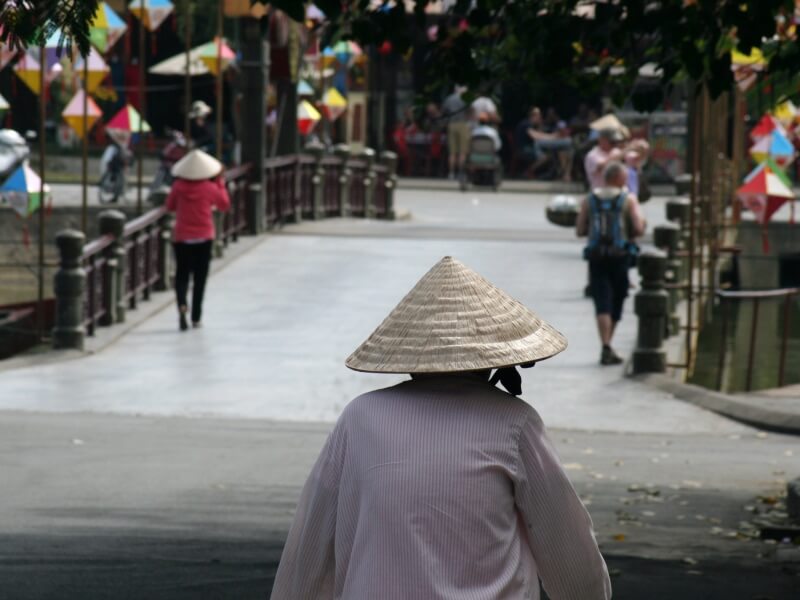
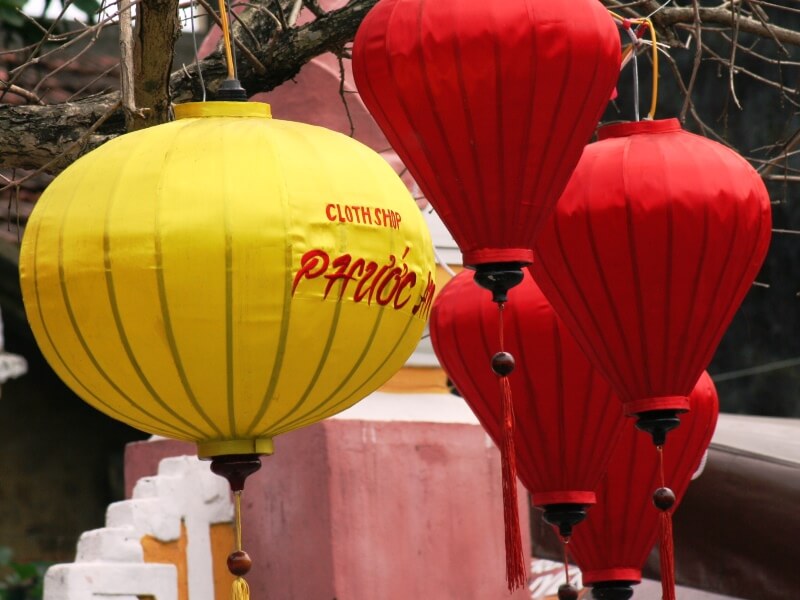
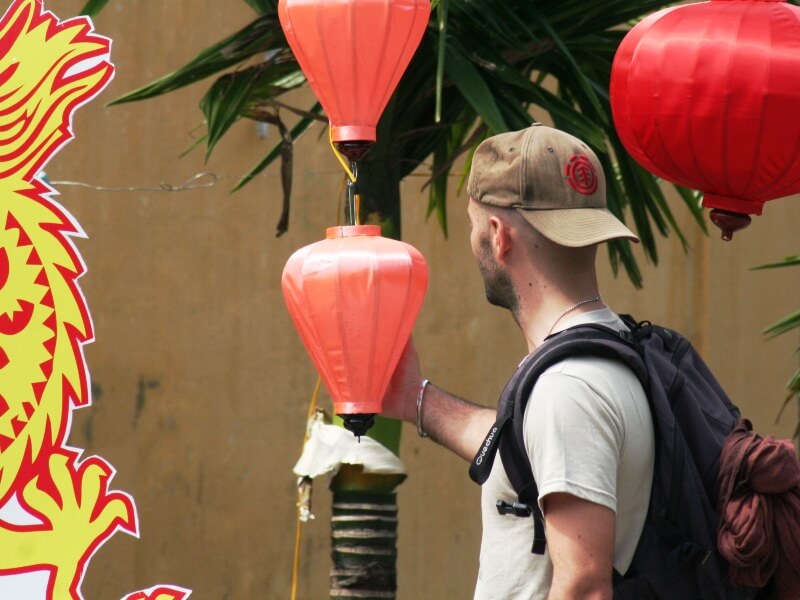

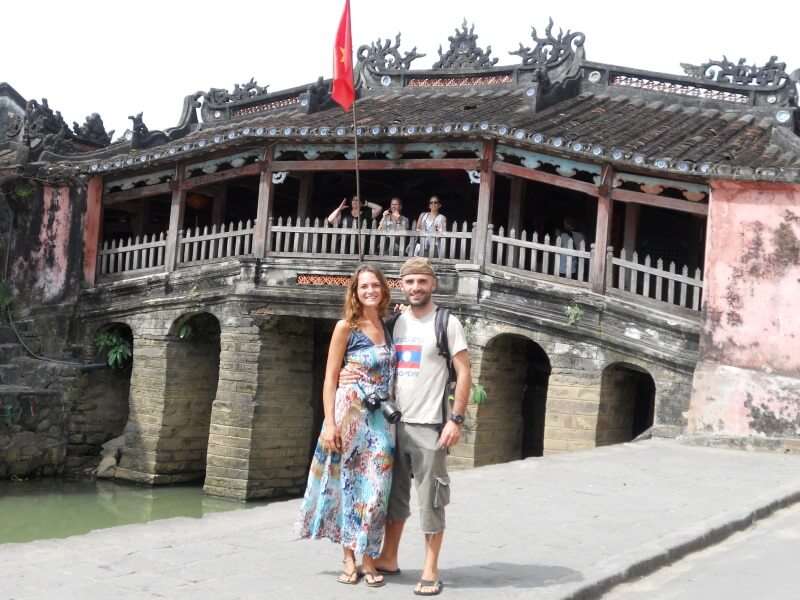


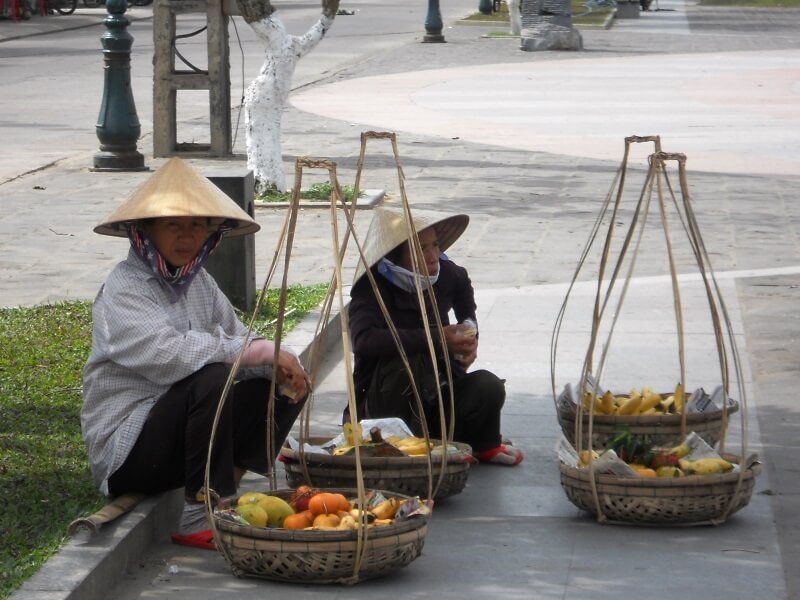
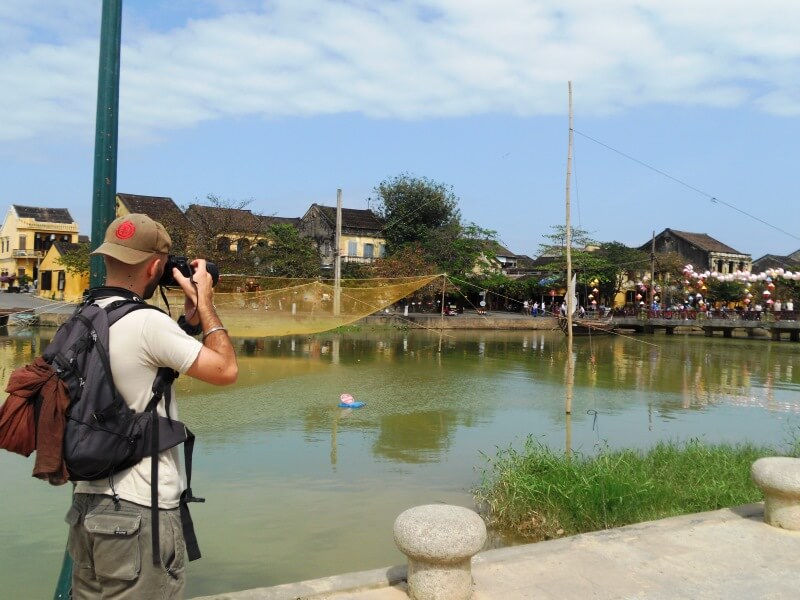
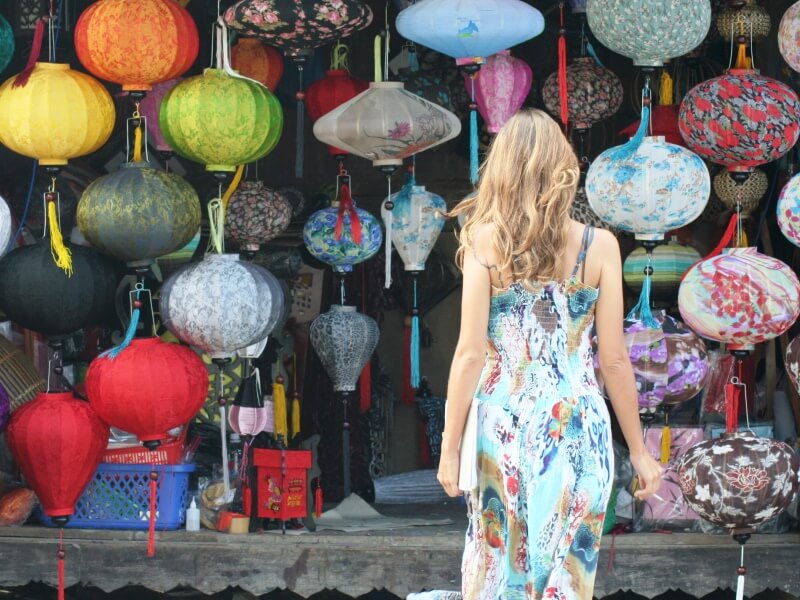
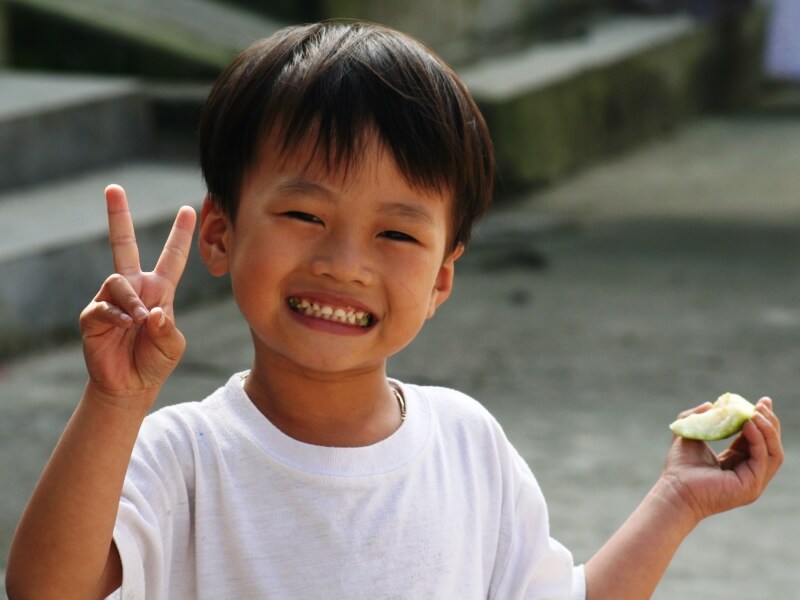
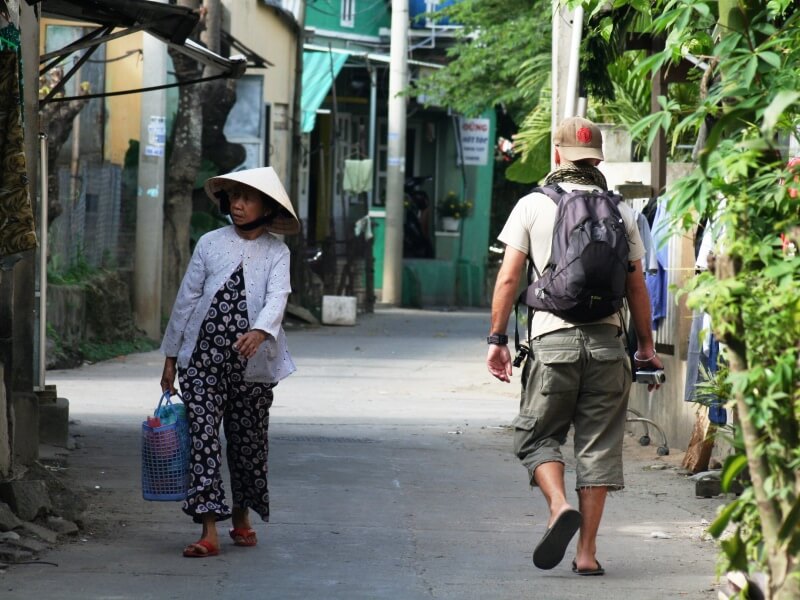
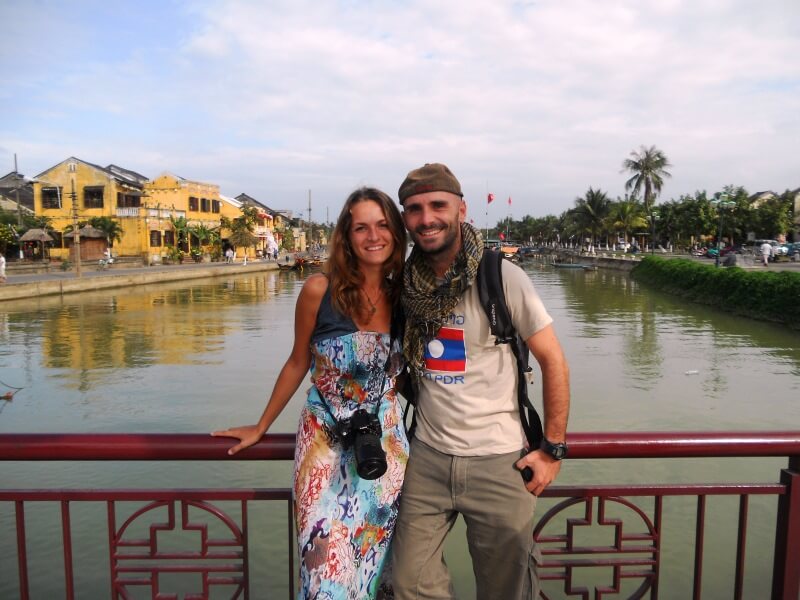
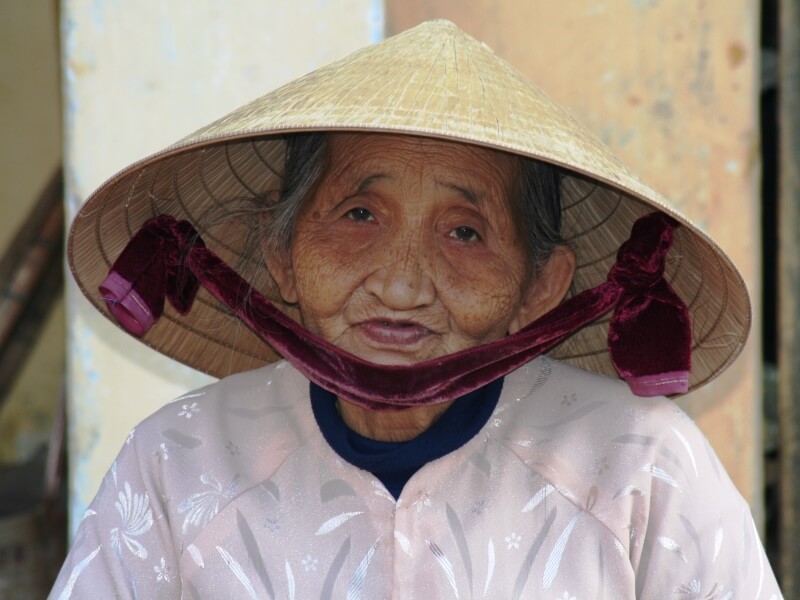
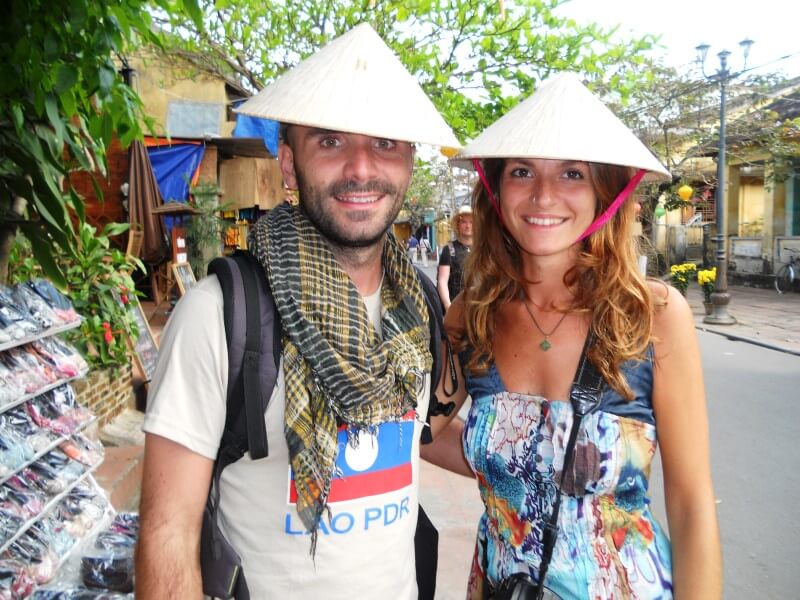
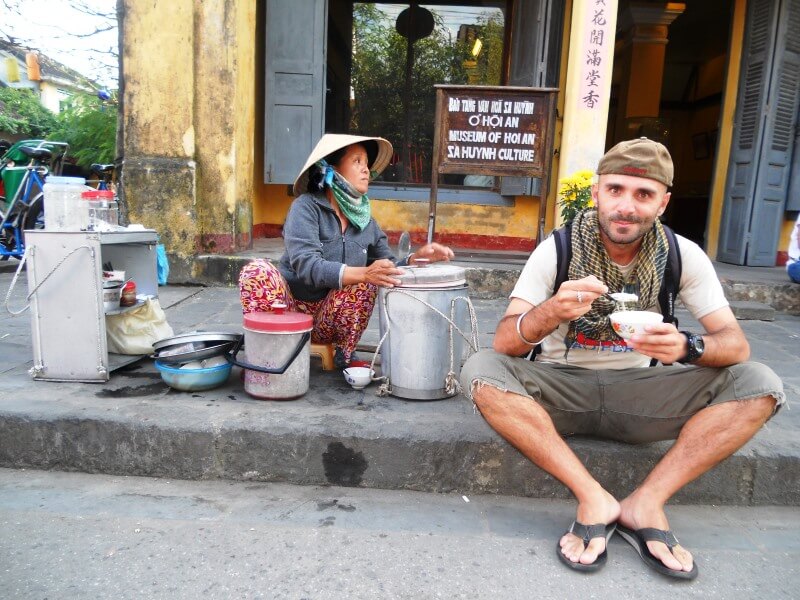

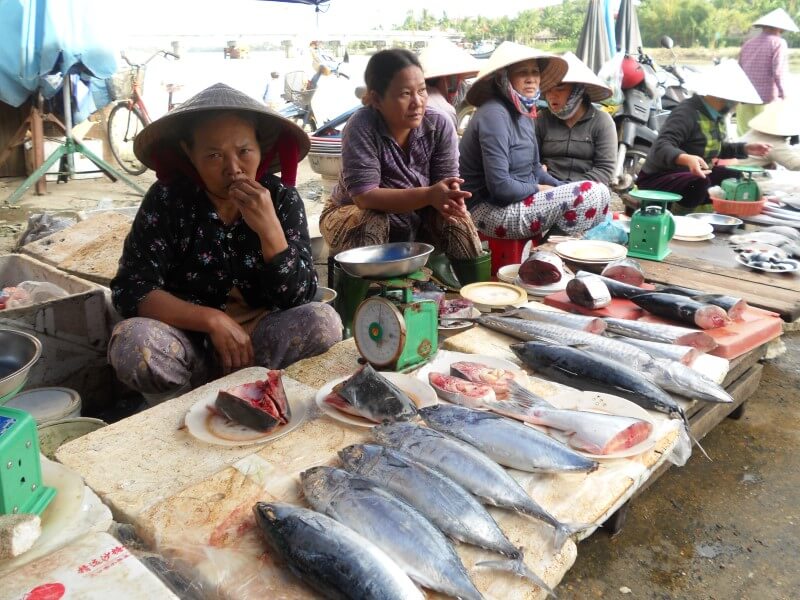
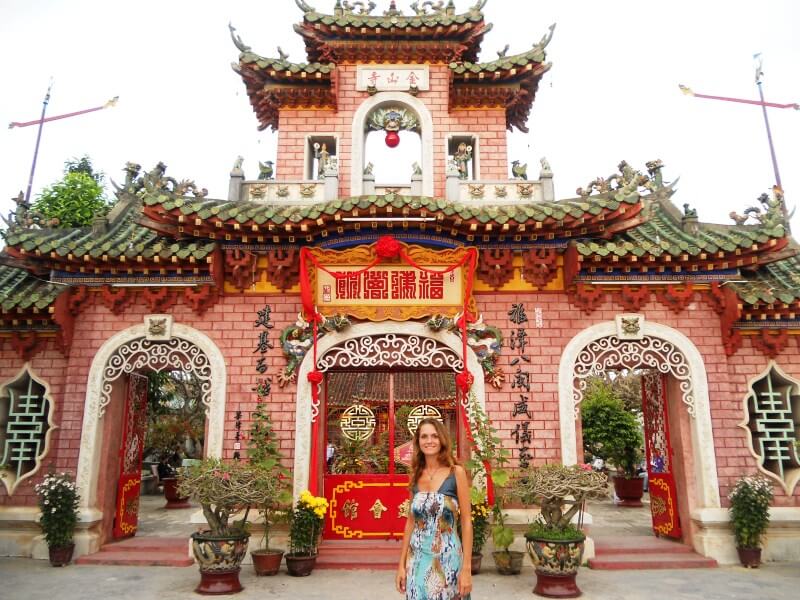
Our journey to the capital continues, this time we stop in old Hue!
Ancient capital, Hue offers numerous testimonies of the history, art and culture of the past, including historic temples and sites related to the period of the Nguyen dynasty.
A visit to the Imperial City (Hoang Thanh) takes at least half a day. Do not miss the Palace of Supreme Harmony and the temples in the southwestern corner of the complex.
Among the imperial tombs stands the great Minh Mang Mausoleum, which includes several richly decorated buildings and a large park, and the Tu Duc Mausoleum.
Among the unmissable temples the Pagoda of Thien Mu, one of the most dear temples to the Vietnamese people. The River of Perfumes flows placidly nearby. Of the Van Mieu only a few fascinating vestiges remain.
The surroundings are also worth visiting, a fascinating rural setting.
Last night bus to the capital of Vietnam.
It's cold, long pants, two sweatshirts and socks… I wasn't used to it anymore! Let's go back to the chaos of scooters and bicycles again!
The capital of Vietnam is a fascinating city, full of places of historical, artistic, cultural and religious significance. What seduces the visitor most is the vitality of its neighborhoods, teeming with activity from the early hours of dawn and almost deserted in the early hours of the night.
The visit to Hanoi begins at Hoan Kiem Lake, the spiritual and historical heart of the city, a place linked to one of the founding myths of the entire nation. Near the lake, to visit with a slow and pleasant walk, are the Turtle Tower and the ancient Temple of the Jade Mountain. The latter is accessed via a graceful wooden bridge with a lively red livery.
To the north of the lake develops the Old Quarter, a maze of always crowded streets where craftsmanship activities have been carried out for generations. It is one of the most fascinating places in the city and here Hanoi turns out to be one of the Asian capitals most deeply rooted in its history.
We are able to visit the now abandoned Hoa Lo prison which reserved different treatments depending on whether the guest was a local political dissident (who were tortured and massacred) or American pilots (who served their "sentence" playing cards, basketball, dining quietly enough to call it "Hoa Lo Hilton").
On foot we reach Ba Dinh Square where the Ho Chi Minh Mausoleum is located.
We spend the whole day discovering the most hidden corners of this intriguing town!
La Baia di Halong (Vịnh Hạ Long) è una delle mete imperdibili di un viaggio in Vietnam. Nel mezzo del Golfo del Tonchino, a est della città portuale di Hai Phong ,è un ampio braccio di mare punteggiato da una miriade di isole e isolotti di origine carsica.
E’ presente un numero molto limitato di insediamenti umani, consistenti in caratteristici villaggi galleggianti.
Il paesaggio è uno scenario d’estasi per chi ama le manifestazioni titaniche della Natura. Le bizzarre sagome delle formazioni rocciose richiamano le immagini più fantasiose, componendo un quadro sempre vario e sorprendente.
La baia è solitamente visitata con escursioni da Hanoi o crociere di due giorni che consentono di spingersi fuori dei sentieri battuti e visitare anche le baie di Lan Ha e Bai Tu Long.
After having sailed in its waters admiring the wonderful surrounding landscape, we find ourselves in a kayak, alone, to cross a cave to end up in a sort of volcanic crater with walls over 40 meters high rich in vegetation ... we are like two children with noses up, open mouth and amazed eyes… it's just us and that's it.
In the afternoon we visit the Dau Go Caves: gigantic monuments of nature and here our Vietnamese adventure ends!
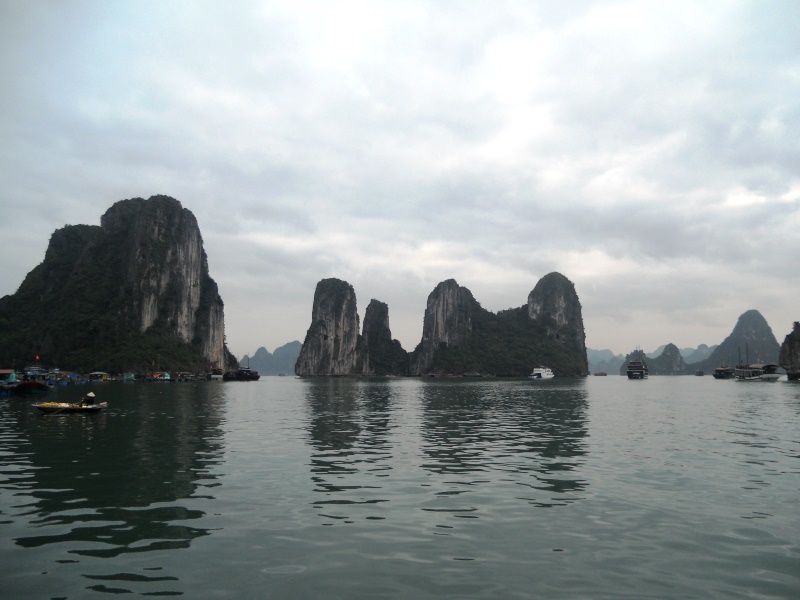
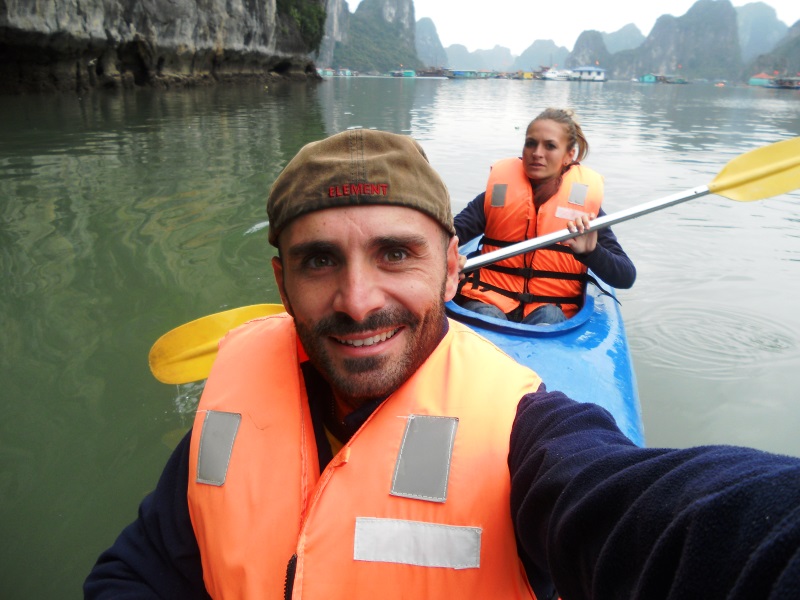
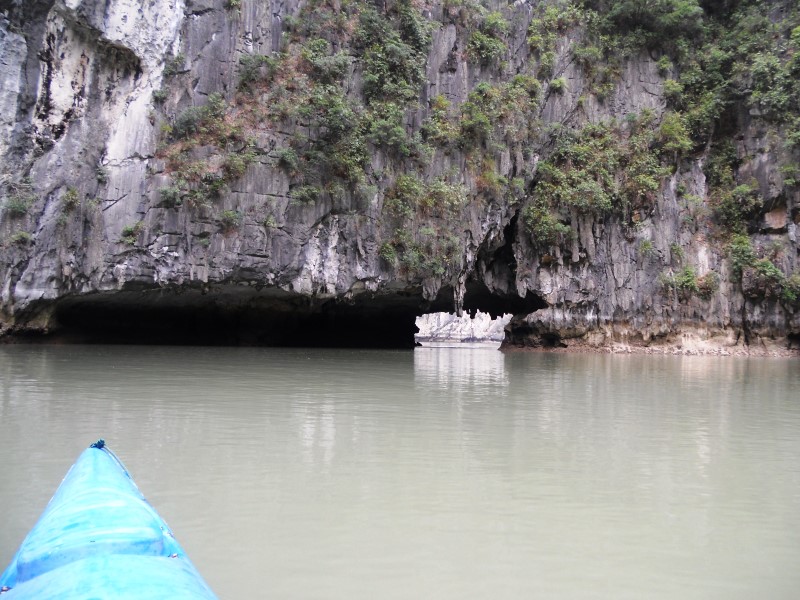
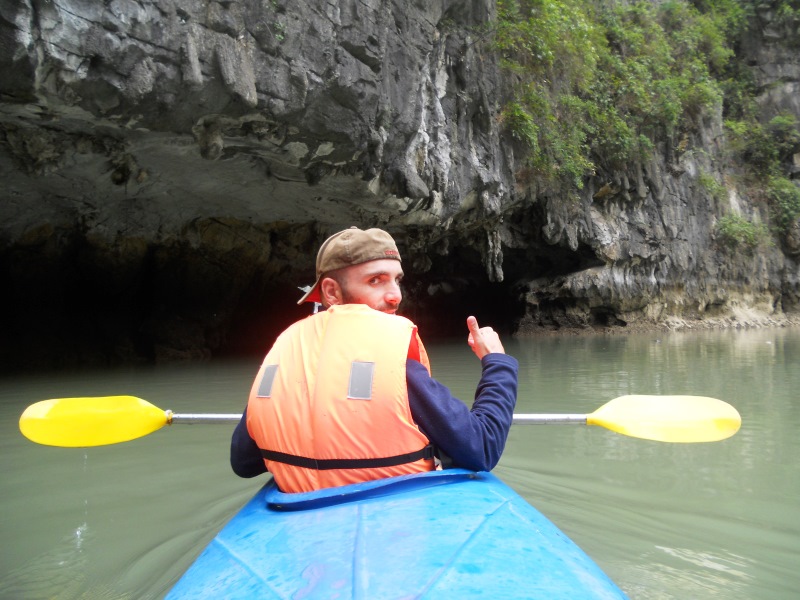
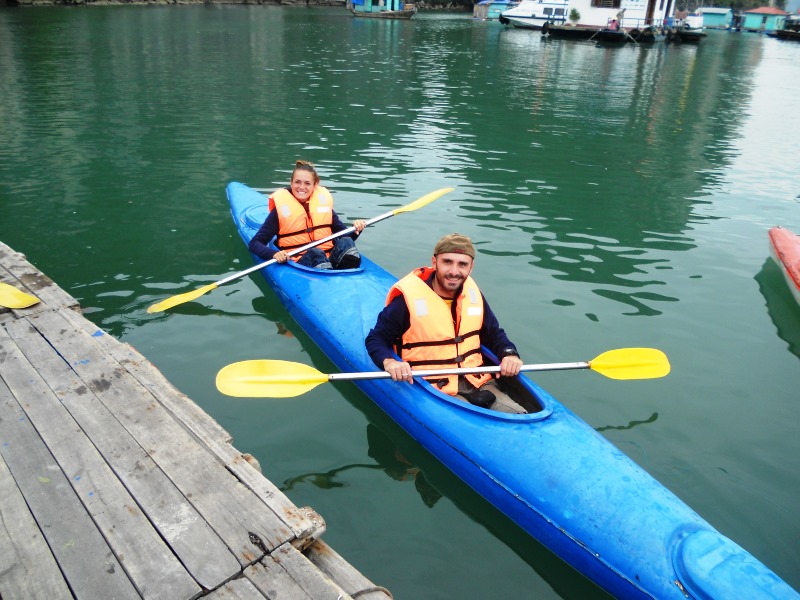
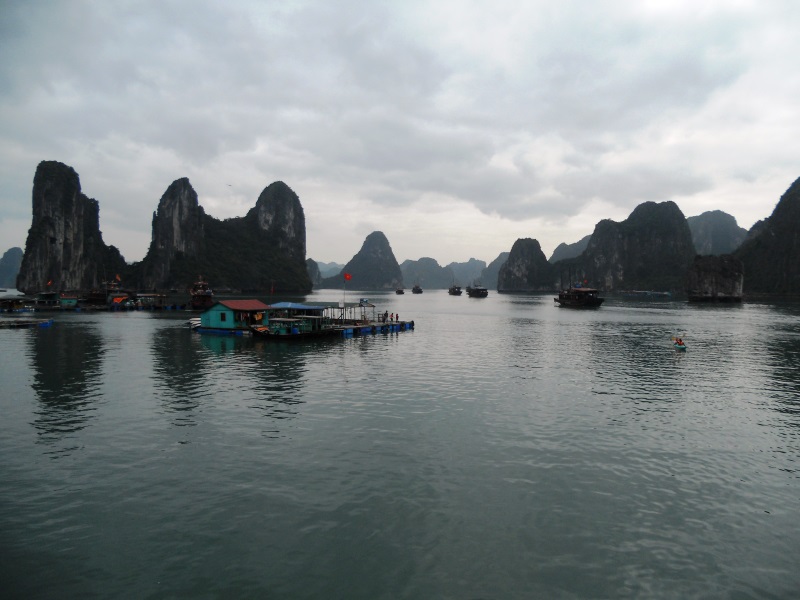
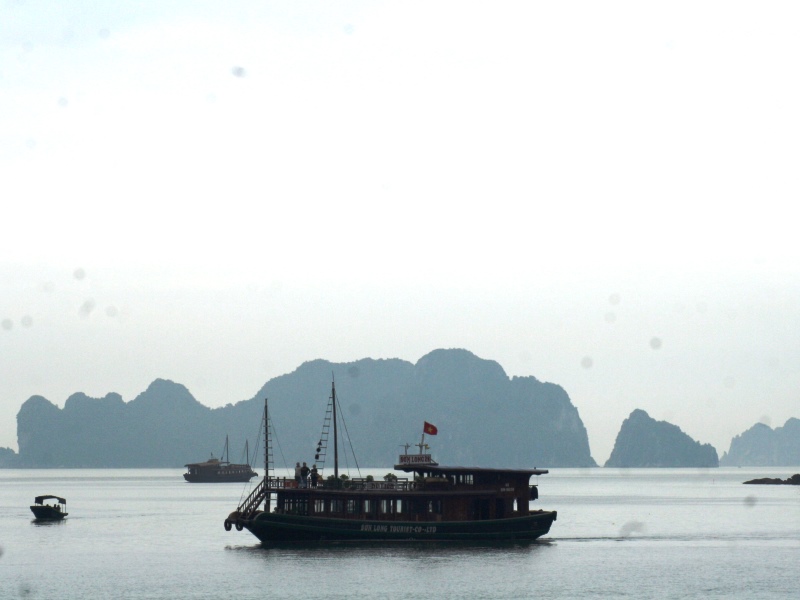
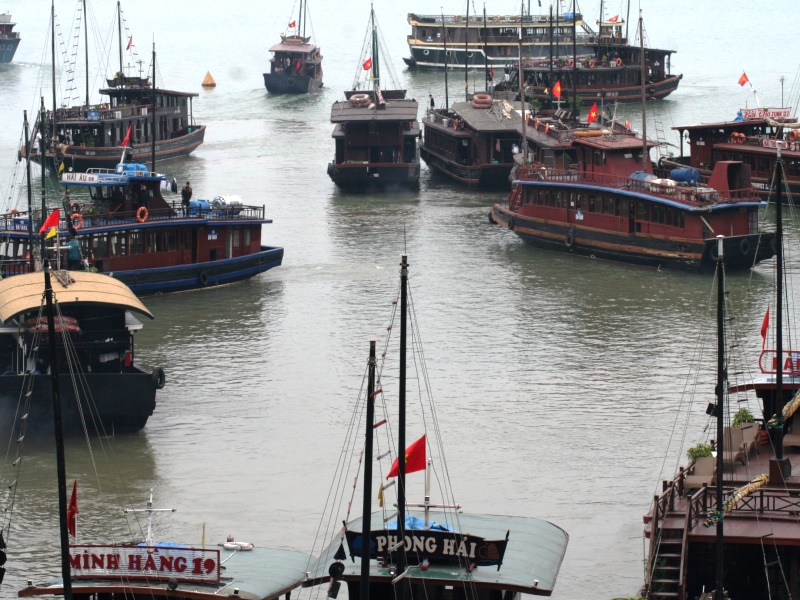
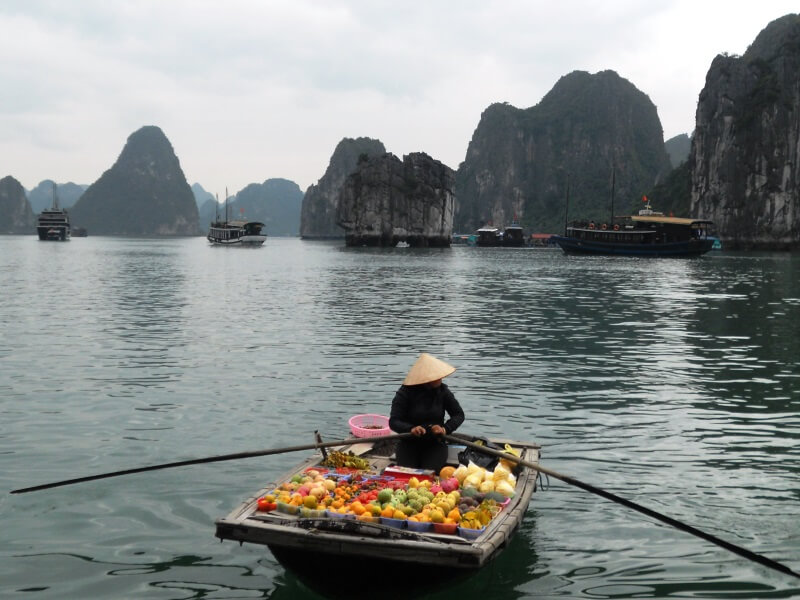
Error: No feed found.
Please go to the Instagram Feed settings page to create a feed.
2 Responses
Thanks for writing this. I really like your article. Your article has proven useful to me. I enjoyed your post. Thank you. Karole Corbett Borman
Thanks Karole, I really appreciate your comment, you have been really kind